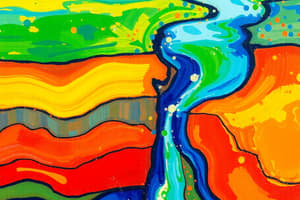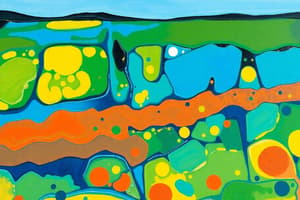Podcast
Questions and Answers
In Canada, about 30.3% of the population depends on ______ as their source of drinking water.
In Canada, about 30.3% of the population depends on ______ as their source of drinking water.
groundwater
In Alberta, Saskatchewan and Manitoba, the primary use of groundwater is for ______.
In Alberta, Saskatchewan and Manitoba, the primary use of groundwater is for ______.
agriculture
Over 60% of New Brunswick’s population depends on ______.
Over 60% of New Brunswick’s population depends on ______.
groundwater
Groundwater can be polluted by sources such as gasoline leakage from storage ______.
Groundwater can be polluted by sources such as gasoline leakage from storage ______.
Approximately 200 billion litres of groundwater are used for agriculture each ______ in the USA.
Approximately 200 billion litres of groundwater are used for agriculture each ______ in the USA.
Oceans hold 96.5% of Earth’s ______.
Oceans hold 96.5% of Earth’s ______.
Less than 3% of Earth’s water is ______.
Less than 3% of Earth’s water is ______.
AQUIFER is an underground formation of permeable rock or loose materials capable of producing useful quantities of water for ______.
AQUIFER is an underground formation of permeable rock or loose materials capable of producing useful quantities of water for ______.
68% of freshwater is found in glaciers and ice ______.
68% of freshwater is found in glaciers and ice ______.
A large proportion of groundwater is used in agriculture to water crops and ______.
A large proportion of groundwater is used in agriculture to water crops and ______.
Groundwater exists underground in ______ zones.
Groundwater exists underground in ______ zones.
Groundwater can move at different speeds depending on ______ sizes and how well connected pores are.
Groundwater can move at different speeds depending on ______ sizes and how well connected pores are.
The upper surface of the saturated zone is called the ______ table.
The upper surface of the saturated zone is called the ______ table.
A fraction of precipitation that falls to Earth seeps its way down into the ground, ultimately reaching the ______.
A fraction of precipitation that falls to Earth seeps its way down into the ground, ultimately reaching the ______.
Groundwater fills pores and ______ in underground materials.
Groundwater fills pores and ______ in underground materials.
Adding new water to aquifers is known as the ______ of aquifers.
Adding new water to aquifers is known as the ______ of aquifers.
An aquifer is an underground layer of water-saturated porous ______.
An aquifer is an underground layer of water-saturated porous ______.
A groundwater scientist is known as a ______.
A groundwater scientist is known as a ______.
Water found in saturated pore spaces is what we refer to as ______.
Water found in saturated pore spaces is what we refer to as ______.
The world's largest groundwater aquifer is the Great Artesian ______.
The world's largest groundwater aquifer is the Great Artesian ______.
At some locations, ground level may be lower than the water ______.
At some locations, ground level may be lower than the water ______.
Flashcards
Groundwater
Groundwater
Water found underground in saturated zones, where soil pores are completely filled with water.
Aquifer
Aquifer
An underground layer of saturated porous rock, fractures, or unconsolidated materials (like gravel, sand) that holds groundwater.
Saturated Zone
Saturated Zone
The underground layer where all pore spaces in the soil are filled with water.
Unsaturated Zone
Unsaturated Zone
Signup and view all the flashcards
Water Table
Water Table
Signup and view all the flashcards
Pore Space
Pore Space
Signup and view all the flashcards
Porous Rock
Porous Rock
Signup and view all the flashcards
Freshwater
Freshwater
Signup and view all the flashcards
What is the primary use of groundwater in Alberta, Saskatchewan, and Manitoba?
What is the primary use of groundwater in Alberta, Saskatchewan, and Manitoba?
Signup and view all the flashcards
What is the primary use of groundwater in Quebec?
What is the primary use of groundwater in Quebec?
Signup and view all the flashcards
What are some sources of groundwater contamination?
What are some sources of groundwater contamination?
Signup and view all the flashcards
Where are most people dependent on groundwater located?
Where are most people dependent on groundwater located?
Signup and view all the flashcards
How much groundwater is used for agriculture in the USA each day?
How much groundwater is used for agriculture in the USA each day?
Signup and view all the flashcards
What does 'recharge' mean for aquifers?
What does 'recharge' mean for aquifers?
Signup and view all the flashcards
What's a 'hydrogeologist'?
What's a 'hydrogeologist'?
Signup and view all the flashcards
What are the different sizes of aquifers?
What are the different sizes of aquifers?
Signup and view all the flashcards
How does the water table affect an aquifer?
How does the water table affect an aquifer?
Signup and view all the flashcards
What is significant about the Great Artesian Basin?
What is significant about the Great Artesian Basin?
Signup and view all the flashcards
What is a 'spring'?
What is a 'spring'?
Signup and view all the flashcards
What happens when ground level is lower than the water table?
What happens when ground level is lower than the water table?
Signup and view all the flashcards
What is the role of pore size in groundwater movement?
What is the role of pore size in groundwater movement?
Signup and view all the flashcards
Study Notes
Groundwater
- Oceans hold 96.5% of Earth's water
- Freshwater exists in rivers, lakes, glaciers, ice caps, soil moisture, and groundwater aquifers
- Groundwater is a significant source of freshwater
- Groundwater is not as visually apparent as surface water, but it is crucial for life on Earth
Groundwater Aquifers
- Groundwater fills pores and fractures in underground materials
- An aquifer is a layer of saturated rock, fractures, unconsolidated materials (gravel, sand, silt, clay)
- Aquifers can be large or small, and vary in depth
- Aquifers are often located close to the Earth's surface, but not always
Groundwater Recharge
- Precipitation, including rain and snow, seeps into the ground and replenishes groundwater reservoirs
- Surface water (rivers, lakes) can also recharge aquifers through rock fractures
- Groundwater can stay in aquifers for thousands of years
Groundwater Usage
- Agriculture is a major consumer of groundwater, with billions of liters used each day globally
- Groundwater is used for drinking water
- Industry also utilizes groundwater
Groundwater Contamination
- Groundwater can be contaminated by various sources
- Gasoline leaks from tanks
- Chemical leaks from industrial waste
- Pesticides and fertilizers
- Manure and biological waste
- Landfills can release contaminants into groundwater
- Groundwater pollution is an environmental concern
Groundwater Location
- Groundwater is typically found within 100 meters of the Earth's surface, although it can be located deeper in certain locations
- Two-thirds of people relying on groundwater in Canada live in rural areas
- Prince Edward Island and New Brunswick get most of their water from groundwater
- 30.3% (8.9 million people) in Canada use groundwater as their drinking water
Groundwater Scientists
- Groundwater scientists are known as hydrogeologists
- Groundwater aquifers vary in size (from a few thousand square meters to thousands of square kilometers)
- Groundwater aquifers can vary in thickness (from a few meters to hundreds of meters)
- Groundwater tables can vary in depth
Springs
- Springs are locations where groundwater flows out onto the Earth's surface
- Springs provide a surface water source
- Groundwater levels can sometimes be lower than the earth's surface, causing groundwater to flow to the surface
Studying That Suits You
Use AI to generate personalized quizzes and flashcards to suit your learning preferences.



